Politics
Tear Down the Confederate Monuments—But What Next? 12 Art Historians and Scholars on the Way Forward
artnet News asks 12 experts how best to advance the cause of justice.
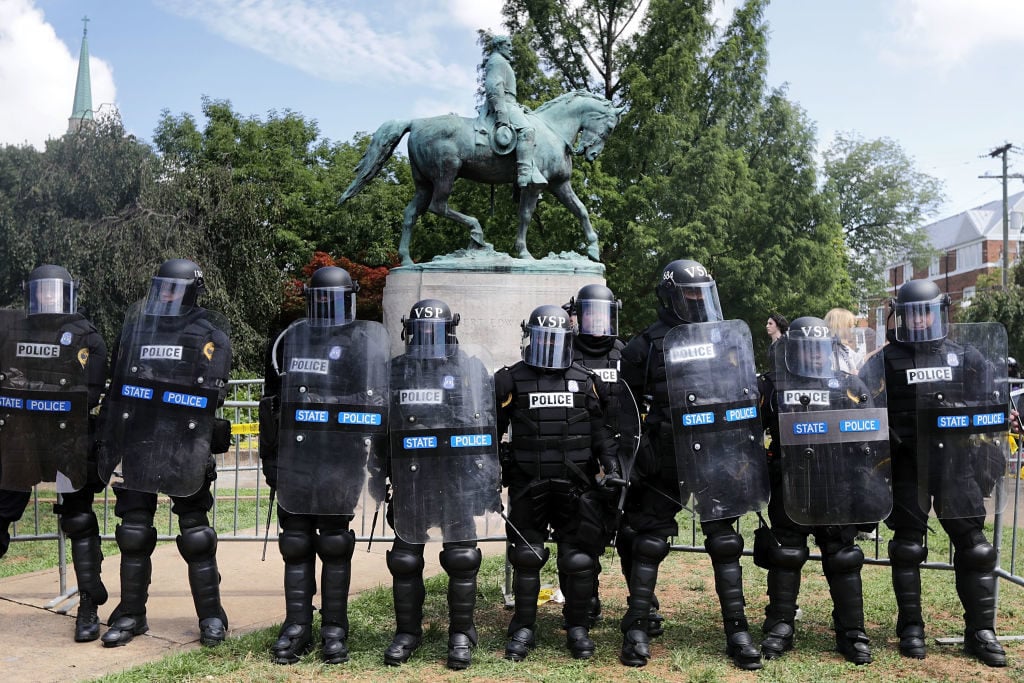
artnet News asks 12 experts how best to advance the cause of justice.

Artnet News

Across the United States, the debate about Confederate memorials and other monuments to a racist past has entered a critical phase. In the wake of the horrifying events of Charlottesville, city governments from Baltimore, Maryland, to Madison, Wisconsin, have been moved to act. Given the role of such monuments as rallying points for an emboldened minority of white nationalists, the case for removal seems clear.
Yet important questions about how to act remain. What is the most effective way to deal with such historically loaded material? Is there a risk in erasing a history that, however loaded, still needs to be studied? Once removed, what is to be done with the disputed monuments? And what kind of models for counter-monuments should be considered, if any?
We asked 12 art historians and experts, who have dedicated their work to exploring the finer points of such matters, for their insight on the debate currently gripping the country. Above all, should Confederate monuments be removed, and if so, how?
Below, we collect their answers.
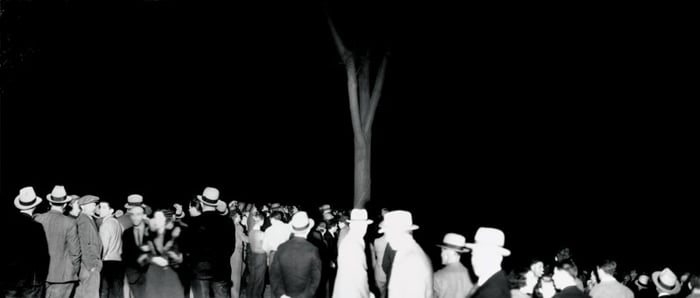
Ken Gonzales-Day, The Wonder Gaze (St. James Park) (2009). Image courtesy Leslie Lohman Museum of Gay and Lesbian Art.
History is written by the victors, or actually by those in power. Since the civil rights movement in the 1960s, culturally specific museums, such as the Leslie-Lohman Museum, El Museo, and The Studio Museum in Harlem, have been reclaiming scholarship and writing history from multiple perspectives, making for a more nuanced and complex interpretation of US history.
Those interested in the future of Confederate symbols (flags, monuments, sites) and how to properly provide interpretations that are nuanced and multifaceted, can take a page from the book of culturally specific museums.
One example that comes to mind is the work of Ken Gonzales-Day, on view at Leslie-Lohman Museum through September 10. The Wonder Gaze (St. James Park) is part of the artist’s “Erased Lynching” series revealing the terrors of America’s shameful past. Gonzales-Day erases the lynched body and rope from historical photos depicting lynchings, allowing the gaze to shift to the crowd of white men and women who assembled to witness the morbid spectacle in front of their eyes. His work is an example of a simple artistic gesture that allows for the reinterpretation of history, opening up new perspectives and allowing for the voices of the “other” to rise above the official history.
I invite historic sites, mainstream museums, and municipal administrations to engage and commission self-identifying queer, Latinx, native, black, and Asian artists to offer new and more inclusive ways to look at their Confederate history.
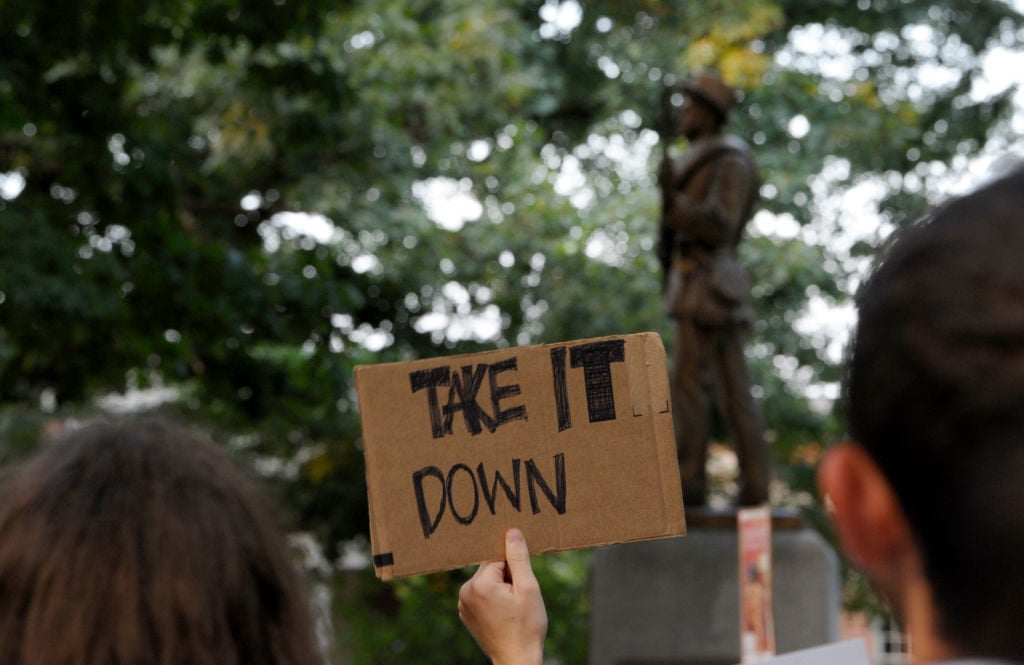
Demonstrators rally for the removal of a Confederate statue coined Silent Sam on the campus of the University of Chapel Hill on August 22, 2017 in Chapel Hill North Carolina. Photo by Sara D. Davis/Getty Images.
I feel little sense of worry over the sight of crowds vandalizing and destroying Confederate statues, certainly nothing near the horror and sadness I felt at the Taliban’s detonation of the Buddhas of Bamiyan or the looting of the National Museum of Iraq.
These Confederate statues are symbols of white supremacy, racial violence sealed in stone and bronze. They manifest the notion that the question of race has been heroically settled, that “white” shall ever prevail over “non-white,” an answer that no longer admits the challenge of any facts, old or new, let alone ideas.
In their time, these statues were meant to enforce terror and segregation. Their functions were rarely aesthetic, and always immoral. It cannot be surprising that they should now be challenged in the way that they are. Finally, thankfully, people’s movements have contravened their purpose.
As objects, some statues may have preservationist value. Which of them do and why may be worthy fodder for debates to have. But that debate is not the main point. America’s fatal flaw is its racial amnesia. That’s why these singular objects matter less than the charged discussions they have collectively provoked.
It’s true that Trump’s endorsement has given white supremacists attention wildly disproportionate to their numbers or intelligence. But long-suppressed histories and memories of violence against those deemed “non-white”—the kind of knowledge these statues once sealed away in their casting and, when erected, placed beyond all questioning—are being freed, too.
The toppling of Confederate statues is another step away from racial innocence. Long after the objects are gone—whether pulled down or placed in storage or behind museum glass—the questions will remain: What will we do with what we know now? How do we forge a national consciousness that moves us toward mutuality and openness?
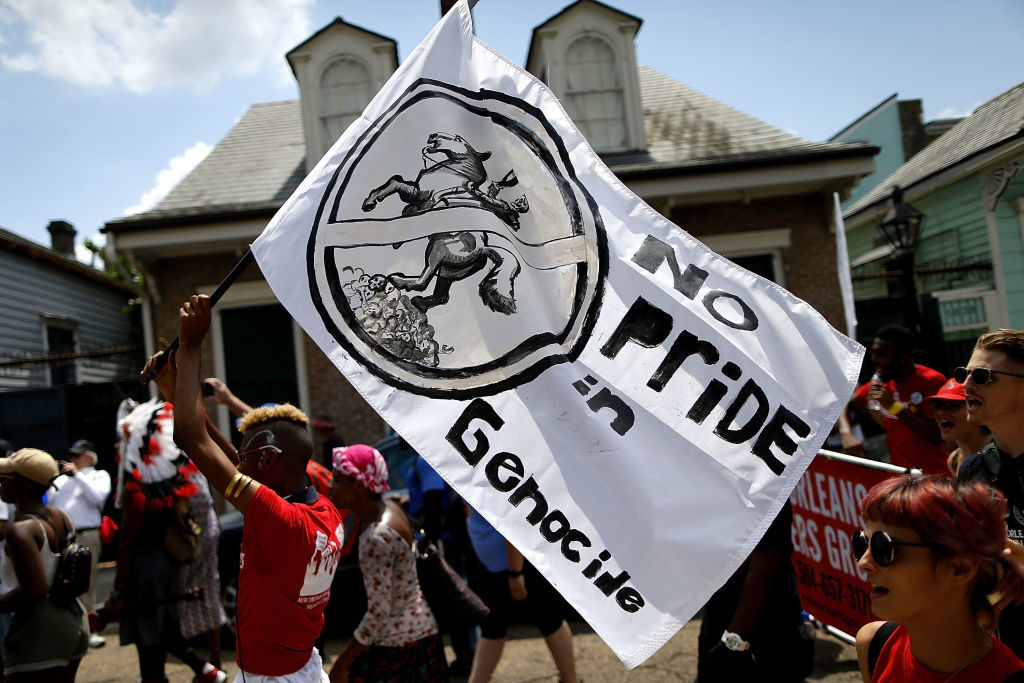
A protester carries a flag in support of removing a monument of Andrew Jackson during a demonstration in solidarity with Charlottesville on August 19, 2017, in New Orleans, Louisiana. Photo by Jonathan Bachman/Getty Images.
The memorials to the Confederacy, in general, celebrate two historical crimes:
1) a treasonous effort to establish an independent nation dedicated to preserving and extending slavery forever
and
2) the late-19th-century effort to deny basic rights of contract and movement to former slaves via murder, rape, arson, and intimidation in the decades after the close of the Civil War.
Most of the monuments were erected in that period of Jim Crow to mark not just the Lost Cause of the Confederacy but also white supremacists’ triumph in wresting control over state and local governments and enacting a regime of racial segregation and oppression.
While individuals in both eras—secession and Jim Crow—possessed interesting and even admirable qualities, the causes the memorials commemorated were, as Ulysses S. Grant wrote, “one of the worst for which a people ever fought.”
Additionally, the memorials proclaim a vision of the South that ignores the fact that four million slaves were Southerners, too, and deserving of representation. When people now say the memorials reflect the history of the South, they are excluding black Southerners from the story of the South that they claim to venerate.
The challenge posed by the memorials arises from two contradictory facts:
a) celebrating terroristic regimes like the Confederacy and Jim Crow is abhorrent
and
b) tearing down the memorials may induce amnesia about how bad those regimes were.
Some historians, therefore, have argued that we should keep the memorials and add large, clear historical explanations of slavery, secession, and the pernicious uses of the memorials to celebrate Jim Crow, supplemented by counter-memorialization of more-admirable Southerners, black and white. Generally, I agree with this as a goal.
On the other hand, some of the memorials are so painful that their historical value is minimal compared to the pain they cause. It is hard to argue that communities should bear the burden of such pain for the edification of others.
Only by engaging carefully with many people on the ground can we hope to decide which of these two methods is most responsive to their needs and most conducive to building, at last, more accurate and inclusive public understandings of the history of the Civil War, Reconstruction, and Jim Crow.
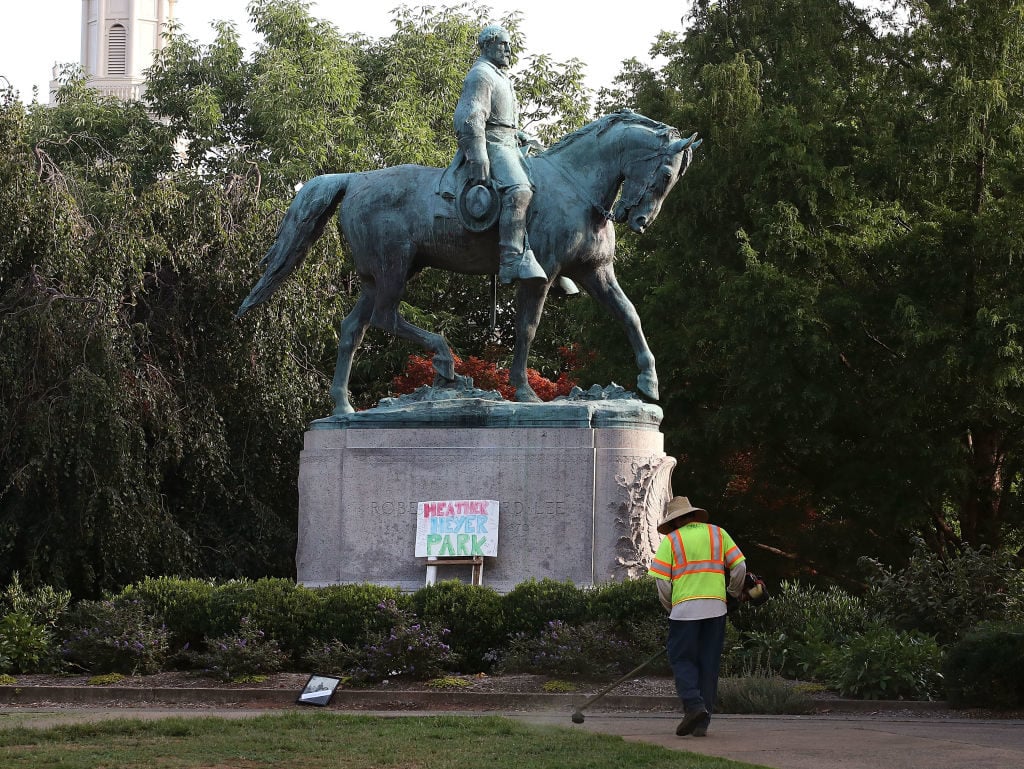
A homemade sign that says “Heather Heyer Park” rests at the base of the statue of Confederate Gen. Robert E. Lee that stands in the center of Emancipation Park on August 18, 2017, in Charlottesville, Virginia. Photo by Mark Wilson/Getty Images.
We must consider how the blatant visual imagery of white supremacy as represented by Confederate monuments shapes our understanding of how we move around in a city’s landscape. We use the phrase “putting someone on a pedestal” as a way to state that we honor and respect someone for their character or deeds. With that in mind, we cannot continue to believe that statues of Civil War Confederate heroes should continue to be venerated in this way.
As Harvard historian and professor of law Annette Gordon-Reed recently stated, the critical difference between discerning the early slave owners’ place in American history (in the George Washington vs. Robert S. Lee argument posed by President Trump) is the roles Confederate leaders, in particular, played in their complicity in ripping the country apart through treasonous acts. Their roles need not continue to be extolled through their statues. Their looming intimidation presence in our national physical landscape should absolutely be removed, and, where possible and appropriate, relocated.
They can be remembered in other ways and in appropriate locations, such as battlefields, regional historical societies, and Civil War or American history museums, whereby their role in American history can be properly contextualized. As fellow art historian and Civil War monuments scholar Sarah Beetham has asserted, I believe that these efforts should be done on the local level so that new monuments can be commissioned and approved by local citizens in a measured, thoughtful, and balanced way.
For this present moment, and for generations to come, it is our imperative as scholars, artists, and American citizens more broadly to take a stand to shape history, especially by way of visual and material culture. This means that local governments must be proactive now in preparing next steps, including considering commissions of new works by both emerging and established artists of all backgrounds who will have new visions by which we can honor overlooked historical figures of the past and burgeoning heroes among us for the future.

Memento Park in Budapest. Photo: Wikimedia Commons.
Yes, I think that removing Confederate monuments makes an important statement that we do not endorse celebrations of white supremacy in public spaces, which is what these monuments do.
They were erected to promote a narrative of the Civil War that glorified defenders of slavery, portrayed slavery as benign, imagined white Southerners as victims, and justified the apartheid system of Jim Crow for the next 75 years. The fact that the white nationalists in Charlottesville were protesting the removal of the statue in order to “take their country back” is a chilling reminder that they know exactly what those monuments symbolize, and that the Civil War is not yet over.
On the other hand, these monuments—or at least images of them—need to be preserved in some way. Perhaps they should be in a park like Memento Park in Budapest, a park dedicated to Communist statues.
One might argue, however, that “museum-ifying” the monuments at all elevates and honors them, and could imply that “both sides were right,” i.e. both sides are entitled to narrate their “own” history. Yet as Frederick Douglass argued in 1878, there was a right side and a wrong side. That is why one would need historical context at such a site and explanation that did not shy away from the insidious origins of these monuments. Again, such a park would be a place to confront the history of white supremacy, slavery, and Jim Crow.
After all, false narratives of the Lost Cause had material and immediate consequences in the decades following the Civil War: They helped to legitimize and naturalize an environment in which African Americans were subjected to repeated attacks, daily humiliations, the purging of black votes, and the domestic terrorism that exploded in the 1890s—the decade during which lynchings were at an all time high. Arguably the persistence of the monuments in our landscape continues to underwrite these practices today.
As a historian, I am loath to destroy evidence of the era and ideology that these monuments represent—after all, we have yet to face the reality of the persistence of these ideas and their consequences. By removing them we risk erasing the past and upholding a myth of white innocence. I would only be in favor of destroying them if we did so publicly, with great ceremony and fanfare, as a collective statement that we confront and reject the ideas that these monuments represent.
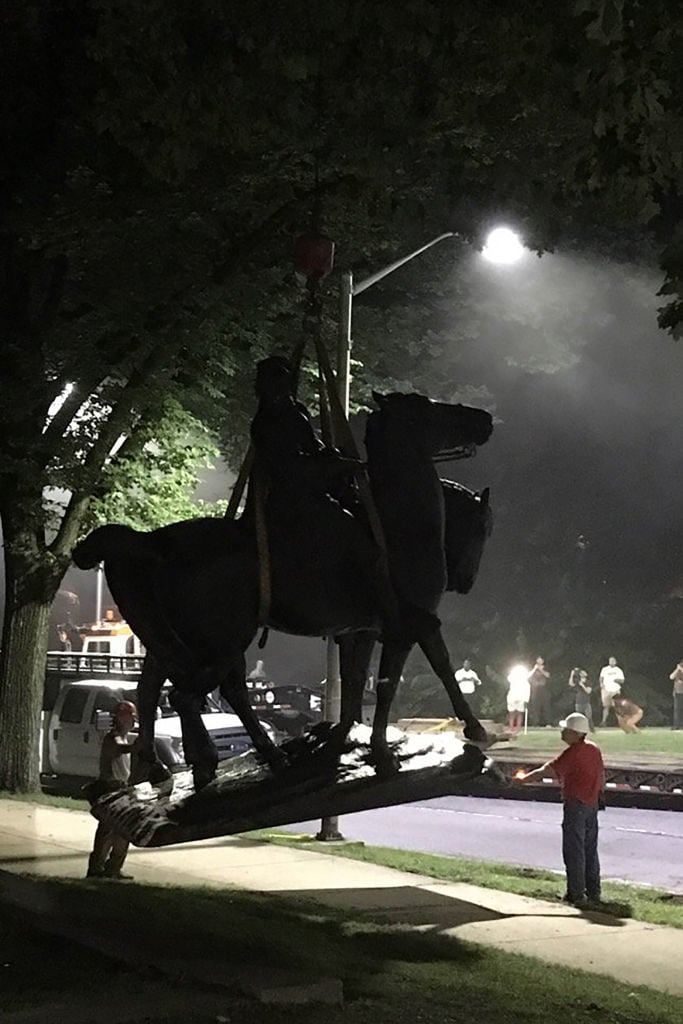
Workers load statues of Confederate generals Robert E. Lee and Thomas “Stonewall” Jackson on a flatbed truck in the early hours of August 16, 2017, in Baltimore, Maryland. Photo by Alec MacGillis/AFP/Getty Images.
Taking down Confederate monuments does not mean erasing the history of the Civil War, the Confederacy, or even white supremacy. Public monuments make a statement about what a community honors and wants to remember.
The people who erected monuments to the Confederacy glorified a movement that made war against the United States and wanted race-based slavery to last forever. It stands to reason that Confederate monuments are rallying points for white supremacists today. They have been so for a long time.
Communities that want to send a message of inclusiveness and democracy should certainly take the monuments down. By all means, put them in museums and other places where visitors will be able to understand them in their true context. Given what they represent, we also need a clear explanation for why they’ve remained in place so long.
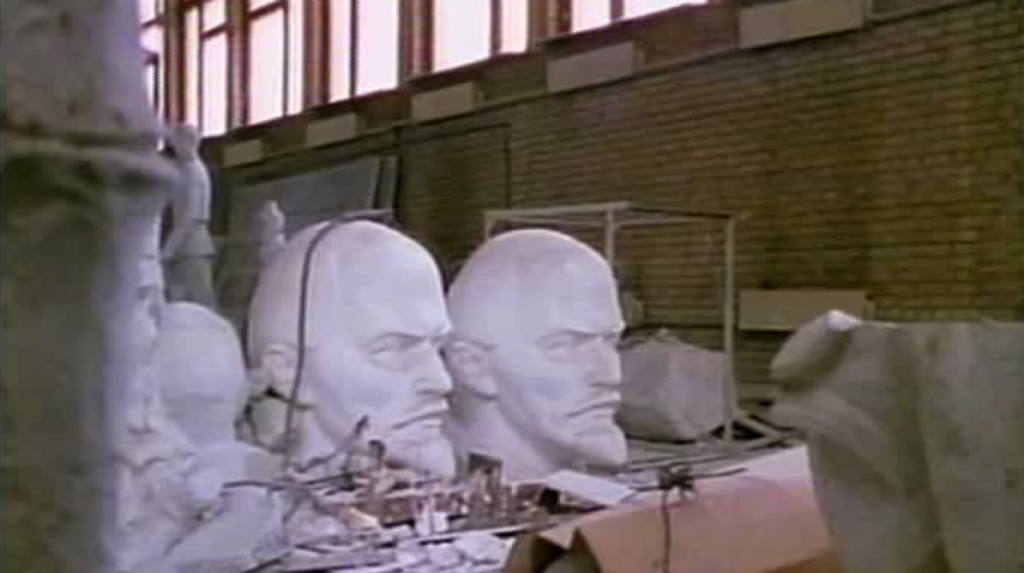
Still from Mark Lewis and Laura Mulvey, Disgraced Monuments (1991).
As a matter of general policy, I think it is right to remove Confederate monuments and the Confederate battle flag from public places. I think they should be treated with the same disrespect as fascist memorials and the swastika in Germany.
I know there is an argument that these are “heritage” objects that commemorate the “Southern way of life” and the heroes who gave their lives for that cause. My suggestion would be that if some private billionaire wants to create a Museum of the Confederacy to preserve these relics of a shameful period in US history, that would be fine. But it should not expect any taxpayer money.
Ideally, moreover, a museum of the Confederacy (does the American Civil War Museum in Richmond, Virginia, count?) would be a critical, historical institution, not a temple for sugar-coating that ugly episode. This would satisfy those who want to see the relics and monuments of that era, without elevating them to the status of American heroes like Abraham Lincoln and Frederick Douglass.
That said, I am not in favor of simply “erasing” all memory of this time. It needs to be re-visited and studied critically for its lingering presence in our time—witness the events of Charlottesville. But the Confederate monuments of recent origin, especially those erected during the ’60s as a rebuke to the civil rights movement, need to be labeled clearly for what their purpose was. And in cases where removal of a monument is not possible or it has a specific artistic or cultural importance, my answer would be to re-contextualize it.
The example of Germany’s treatment of fascist memorials and Eastern Europe’s treatment of the monuments to Communism are exemplary in this regard. Laura Mulvey’s great film, Disgraced Monuments, treats the latter cases of the destruction of Soviet monuments at the end of the Cold War.
I would also want to warn that this is a complex issue that may not be soluble with one simple criterion for removal. While the general principles seem clear—this was an illegitimate, traitorous rebellion against a legitimate democratic government—it will inevitably be worked out on a case-by-case basis. It needs to be debated in a democratic fashion and to have that debate informed by historical knowledge.
At the end of the day, the question of monuments and statues is merely symbolic of a much deeper pathology.
The actual policies of white supremacy are already operative in US housing, employment, medical care, and (most visibly) the prison system. Racism is not just about marches and slogans. It is about the justice system, education, and the everyday violence of a deeply unjust society. This is now being extended to immigrants, and the ICE “police” are emerging as the new shock troops of a kind of ethnic cleansing.
So let’s not get fixated on statues; statutes and their enforcers represent a much deeper pathology.
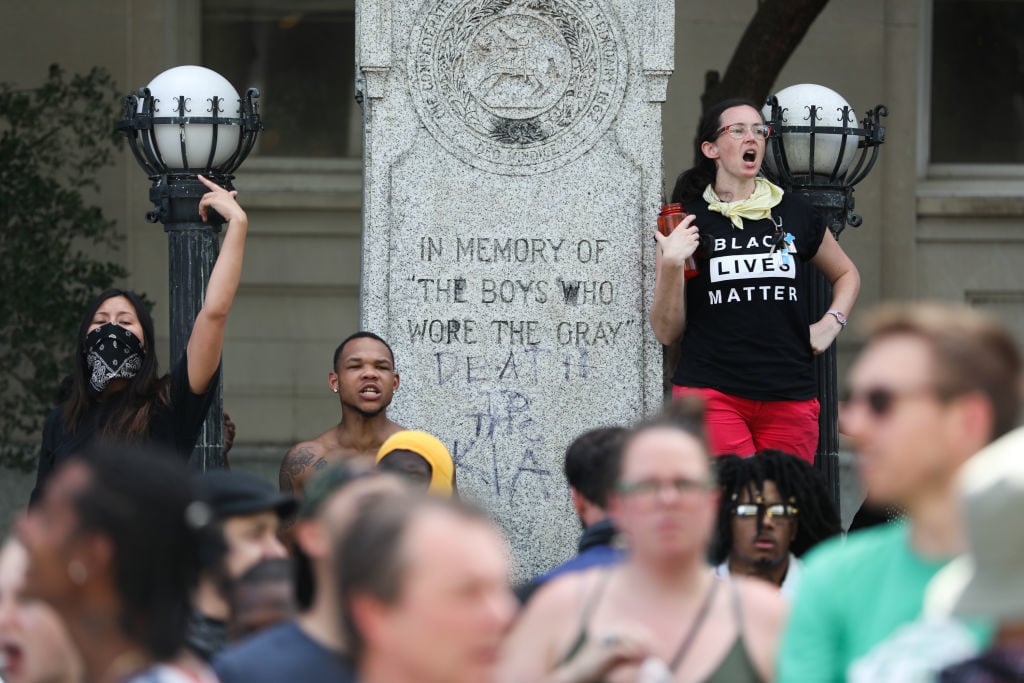
Protesters gather in front of the old Durham County Courthouse where days earlier a confederate statue was toppled by demonstrators, in Durham, North Carolina, on August 18, 2017. Photo Logan Cyrus/AFP/Getty Images.
Seeing the images of protesters kicking and spitting on the toppled Confederate soldier in Durham, NC, one can’t help thinking of iconoclasm. This puts many of us art historians in a quandary.
The lies and smoke screens that supported the Lost Cause and its monuments are now, finally, being exposed in mainstream society. But what should we do with this vast collection of sculpture that honors the only nation on earth ever formed for the express purpose of protecting and supporting the institution of slavery? How do we reconcile the impulse to “conserve” historical objects with the urgent need to repudiate this cause?
For a long time, my answer was that Confederate monuments should be an entry point for a larger dialogue we need to have about racial slavery, white supremacy, and their continuing legacy in the present. The process of confronting the past was more important than the outcome, or so I thought; genuine community dialogue might lead to creatively varied decisions for different monuments.
But now that neo-Nazis have rubbed our collective nose in the evil legacy of these monuments, and taken human life along the way, the time for dialogue is rapidly closing. Local governments are trying to stay one step ahead of the crowds that would tear the monuments down, or celebrate them with orgies of racism.
I think art still has a role to play, however. There is great opportunity for artists to intervene in new ways in the memorial landscape, to expand the possibilities, to change the conversation—whether authorized or not (as long as the actions don’t damage what’s already there). In the act of creation, optimism can still survive.
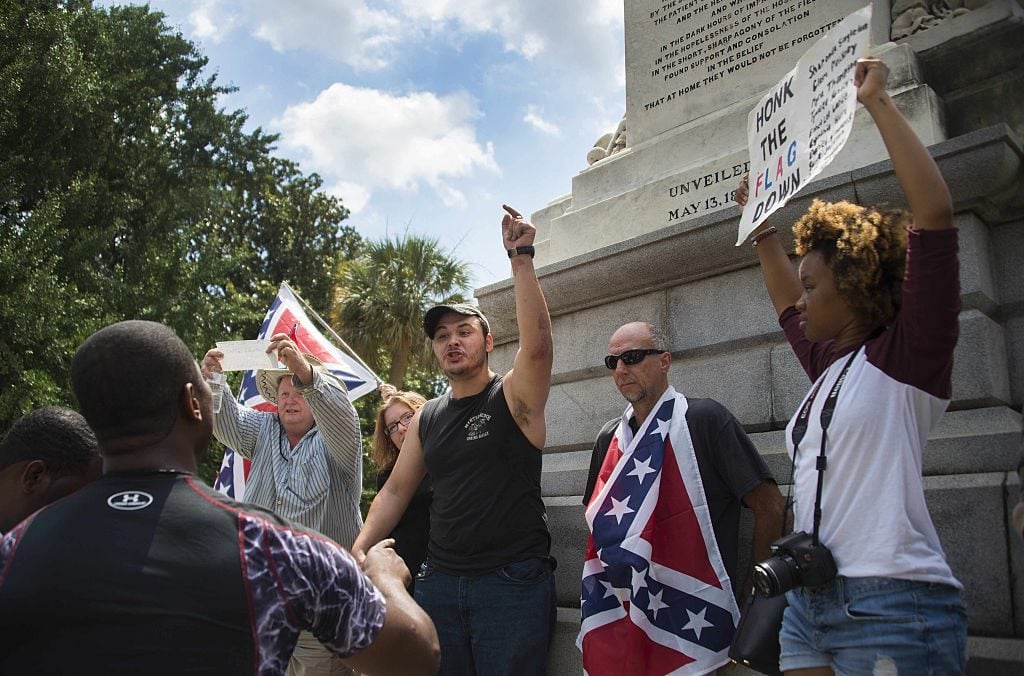
Pro-confederate flag demonstrator Peter Manos (center) argues with anti-confederate flag protester Jalaudin Abdul-Hamib (left) outside the South Carolina State House in Columbia, South Carolina, June 27, 2015. Photo by Jim Watson/AFP/Getty Images.
At the 2018 annual meeting of the College Art Association (Los Angeles), I will be co-chairing a session entitled “Teachable Monuments: Using the Sculptures in our Midst to Spark Dialogue and Address Controversies.”
Teachable Monuments, an initiative begun under the aegis of Public Art Dialogue, advocates for the use of public monuments as a focus for civic and civil dialogues in schools at every level, from kindergarten to university. It also plans to develop guidelines for public officials in communities to help resolve controversies regarding public monuments. It could hardly be more timely.
The current rush to remove Confederate memorials is heartening; such celebrations of a South defined by slavery have no place in our civic spaces where their value system is implicitly condoned by the powers that be.
That said, they should not be destroyed; history cannot and should not be erased in this fashion. Rather, we might consider creating actual or virtual museums where Confederate and other outdated monuments that express value systems that have been rejected by most might be displayed, complete with images of their previous siting(s) and an explanation of their significance at the time of their creation and now.
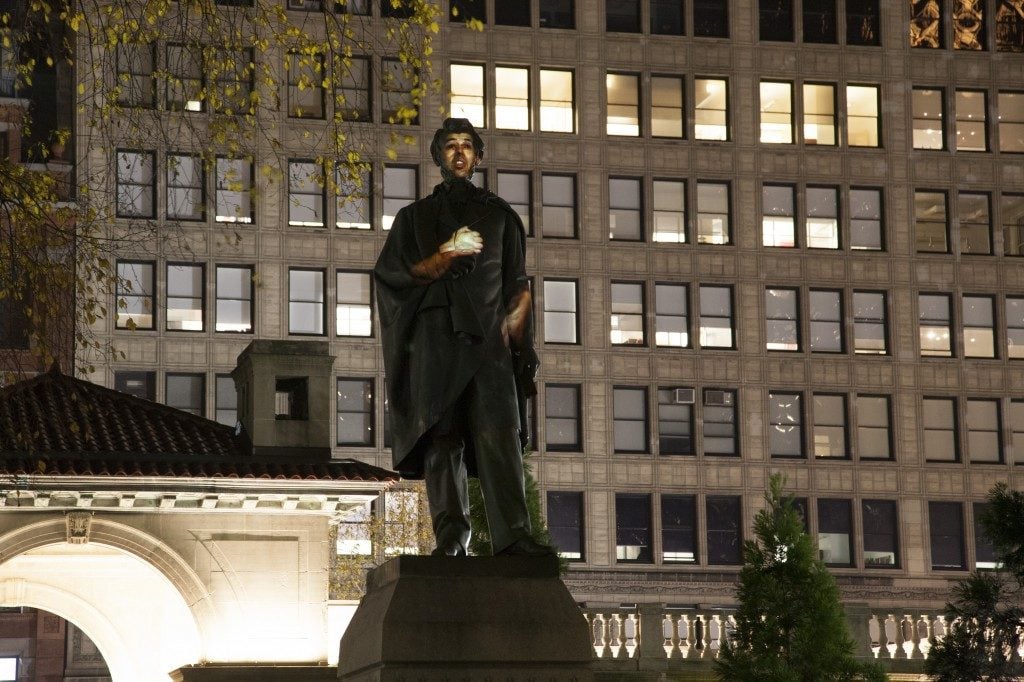
Krzysztof Wodiczko’s Abraham Lincoln: War Veteran Projection (2012), a projection of the testimony of war veterans onto the Abraham Lincoln memorial in Union Square. Image courtesy More Art.
North Carolina, where I live, is one of several states that have passed (in 2015) laws restricting the removal of publicly owned monuments from their existing sites; explicit permission of the legislature is now required. Such laws fly in the face of the continuous flux to which monuments have been subject for a whole range of reasons, practical as well as ideological, over the several millennia of their existence.
Yet the two main solutions for the problem of Confederate monuments floating around social media raise as many questions as they answer.
“Contextualization”—the idea of adding plaques or signs explaining the history of monuments—begs the question of who determines what context is appropriate. I can think of at least three moments of “context”: of the event commemorated, of the construction of the monument, and of the present. There is also the question of how to explain the context to the public. Apps along the lines of museum cell-phone tours would address some but not all of these issues.
On the other hand, the call to “put them in a museum”—perhaps an open-air museum like the Memento Park in Budapest, a home for discarded Stalinist monuments—ignores the limited range of Confederate memorials and the odd match they would make for most museums. They do not meet most art museums’ acquisitions criteria (the New York Times commented on the cheapness of the mass-produced Durham Confederate memorial, which buckled when it hit the ground), and they would pose severe challenges to even the most spacious local historical museum.
In addition, sited in outdoor sculpture parks, displaced Confederate monuments could easily remain attractive to extremist groups. How to justify the expense of guarding and maintaining them? Some monuments will, inevitably, be discarded.
As we start to thinking about what happens after removal (for example, in New Orleans), localities should engage in the widest community consultation possible with all groups willing to engage in civil discourse. They should consider a range of options, including the kinds of critical intervention practiced by Krzysztof Wodiczko at Bunker Hill and elsewhere and by Michael Asher at the Art Institute of Chicago.
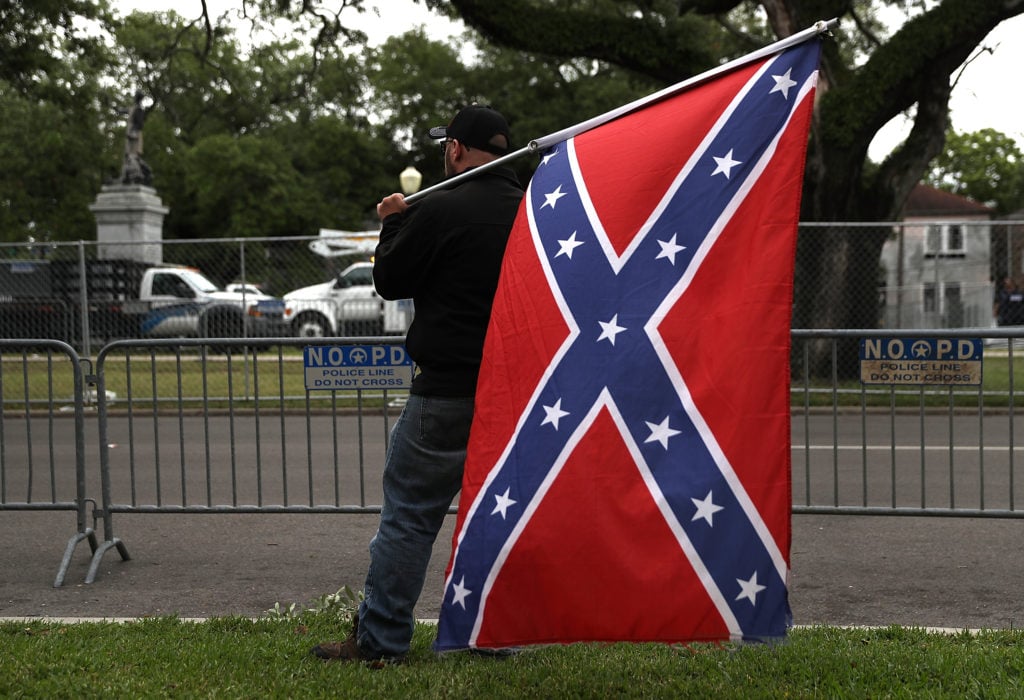
A protester holds a Confederate flag across the street from the Jefferson Davis monument on May 4, 2017, in New Orleans, Louisiana. Photo by Justin Sullivan/Getty Images.
(1) For far too long we have allowed the neo-Confederate interpretation of the Civil War to dominate our public spaces. The monuments to Lee, Davis, and their ilk were erected as powerful symbols of white supremacy and oppression decades after the Civil War ended. It is time to call the Confederacy what it was, stop glorifying its leaders, and move those monuments to a museum where they can be interpreted in all their complexity. I would not have always felt this way, but following the tragic events in Charleston and Charlottesville, a change must come. My ancestors were slave owners who fought for the Confederacy. I take no pride in that, nor am I ashamed of it. They were men of their time and place. But this is our time and our place. We must reclaim our history and send a different message about who our heroes really are.
(2) For me, the monuments debate is over. Like Frederick Douglass, I’m sick of the “nauseating flatteries” of Robert E. Lee. I’ve lost all patience with trying to see this issue through the eyes of the neo-Confederates, neo-Nazis, and unrepentant racists. I prefer to see it through the eyes of the people who have been and continue to be victimized by the white supremacy these monuments celebrate. These monuments were erected as powerful symbols of white supremacy and racial oppression decades after the Civil War ended. It’s time to change course and erect public monuments that unite us, not divide us; monuments that represent who we are, not who we were. Either destroy the monuments or move them to museums where they can be interpreted in all their complexity. Those monuments are more than a nuisance—they are festering wounds on the body politic, and they need to be excised. No true reconciliation will be possible until we confront all that those statues represent.
J. Marion Sims, "father of modern gynecology", memorialized for performing genital surgery on Black woman slaves w/o anesthesia or consent pic.twitter.com/p5hE8S7uCv
— BYP100 (@BYP_100) August 19, 2017
Statues wield a species of semiotic tyranny: Unlike written histories and poems, they do not permit differing interpretations. Their stolid presence speaks to the power, importance, and purported virtue of their individual subjects: These men are heroes.
Those who not believe in the heroism of leaders who sought to destroy the US in order to preserve the profitable enslavement, torture, and murder of African Americans are told that should we remove these, we risk forfeiting beauty, tradition, and an erasure of history. But we should take a page from Germany’s book and acknowledge that symbols that celebrate enslavement and genocide are unacceptable in civilized societies.